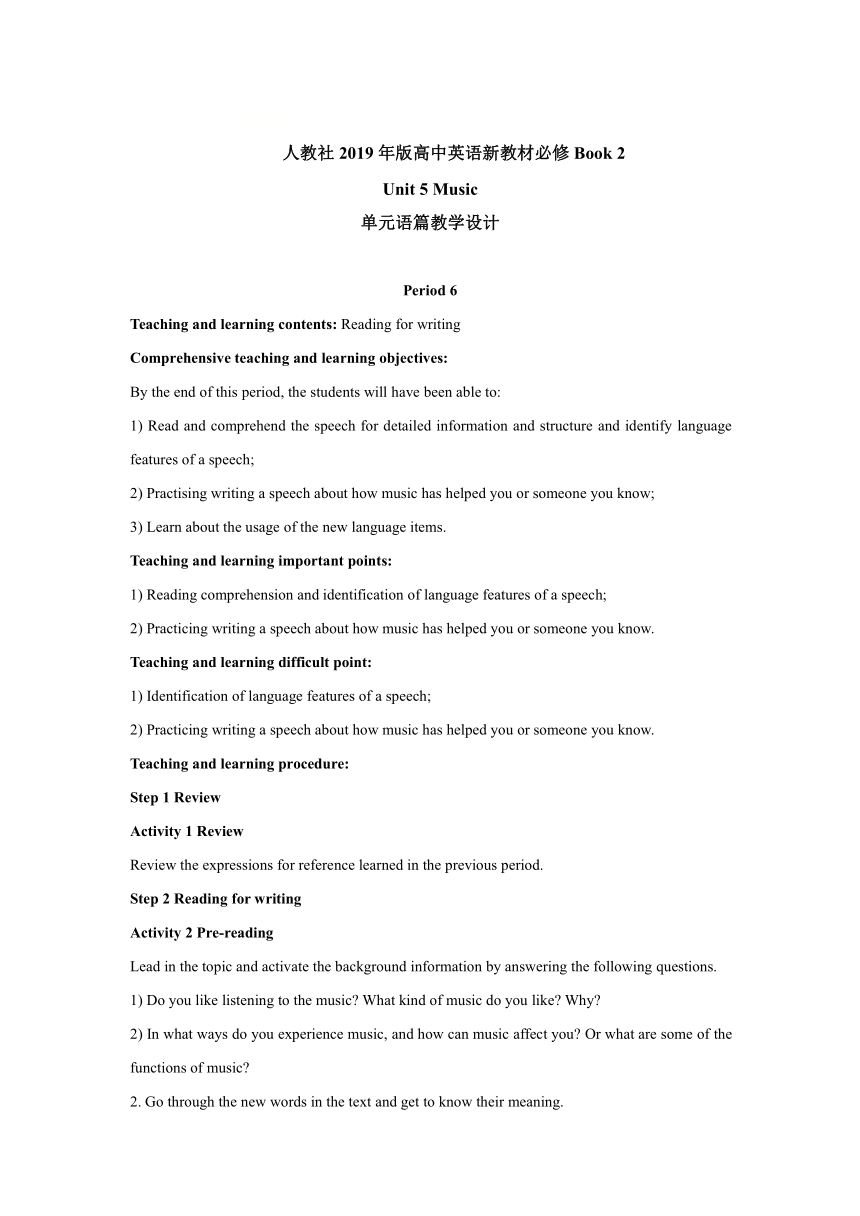
人教社2019年版高中英语新教材必修Book 2 Unit 5 Music 单元语篇教学设计 Period 6 Teaching and learning contents: Reading for writing Comprehensive teaching and learning objectives: By the end of this period, the students will have been able to: 1) Read and comprehend the speech for detailed information and structure and identify language features of a speech; 2) Practising writing a speech about how music has helped you or someone you know; 3) Learn about the usage of the new language items. Teaching and learning important points: 1) Reading comprehension and identification of language features of a speech; 2) Practicing writing a speech about how music has helped you or someone you know. Teaching and learning difficult point: 1) Identification of language features of a speech; 2) Practicing writing a speech about how music has helped you or someone you know. Teaching and learning procedure: Step 1 Review Activity 1 Review Review the expressions for reference learned in the previous period. Step 2 Reading for writing Activity 2 Pre-reading Lead in the topic and activate the background information by answering the following questions. 1) Do you like listening to the music What kind of music do you like Why 2) In what ways do you experience music, and how can music affect you Or what are some of the functions of music 2. Go through the new words in the text and get to know their meaning. New words: disease, ach, treatment, satisfaction, being, various. Activity 3 Reading comprehension 1. Read or listen to text and then answer the questions. 1) What was Sarah’s problem Sarah had a serious disease which was difficult to cure. 2) How did music help her during her difficult time It made her feel much better because it is the “medicine of the mind”. 3) What is her advice to others Her advice to others is to use music to help when you have problems. 2. Guide the students to analyse the structure of a speech. Part 1 (Paragraph 1) Beginning Welcome the audience: Good morning! Introduce yourself: My name is… Propose the topic: It’s an honor to be here and to share with you the story of how music has had an impact on my life. Part 2 Main body (Paragraph 2-3) Personal experience/anecdote: the second paragraph Personal feeling: the third paragraph Part 3 End (Paragraph 4) Close the speech: the fourth paragraph Thank the audience at the end: Thank you! 3. Study the language features. 1) Explain the rhetorical devices and then get the students to match the names of rhetorical devices to the lettered sentences in the speech. Rhetorical devices: (1) Simile 明喻 A simile compares two things by using words such as “like” or “as”. e.g. Little Kitty is as cute as a cat. (2) Metaphor 隐喻 A metaphor compares two things that are unrelated, but which are similar in some way. e.g. That businessman is a real fox. (3) Rhetorical question 设问 A rhetorical question is a question that isn’t meant to elicit an answer, but is asked to make a point. e.g. How could I be so ... ...
~~ 您好,已阅读到文档的结尾了 ~~

